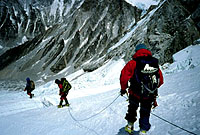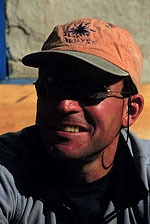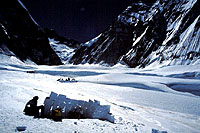 |
 |
 |
 Assault on the Summit
Assault on the Summitpart 5 | back to part 4 Altitude and the Lungs: Pulmonary Edema More common is High Altitude Pulmonary Edema (HAPE), the water-logging that can flood the lungs, the most frequent cause of death from mountain sickness. Normally the fluid that collects naturally in the tissues around the lungs is absorbed quickly without symptoms, but even a minor cold can provoke this fluid to increase, leading to HAPE, where one literally drowns in their own fluids. Rest and breathing oxygen will help, but if HAPE or HACE get worse, rapid descent is necessary. "Pressurizing" the climber (for a few hours) in an inflatable bag, a so-called Gamov Bag, may also help. If needed, such bags are available at Base Camp and Advanced Base Camp (ABC). Climbing Without Oxygen  Ed is the only team member climbing without breathing bottled oxygen. "When I
first attempt a Himalayan peak," he explains, "I try to climb without oxygen,
even if it keeps me from reaching the summit. My personal goal is to see how I
can perform, to experience the mountain for what it is without reducing it to
my level. Altitude isn't all of it. There's the snow conditions, the weather,
your attitude, your health, your strength—all of these must come together on
the summit day. But I always tell people that when you are climbing, it's a
round trip. Getting to the summit is optional, getting down is mandatory."
Since Reinhold Messner's historic first summit of Everest without oxygen in
1978, more than fifty climbers have reached Everest's summit without
oxygen.
Ed is the only team member climbing without breathing bottled oxygen. "When I
first attempt a Himalayan peak," he explains, "I try to climb without oxygen,
even if it keeps me from reaching the summit. My personal goal is to see how I
can perform, to experience the mountain for what it is without reducing it to
my level. Altitude isn't all of it. There's the snow conditions, the weather,
your attitude, your health, your strength—all of these must come together on
the summit day. But I always tell people that when you are climbing, it's a
round trip. Getting to the summit is optional, getting down is mandatory."
Since Reinhold Messner's historic first summit of Everest without oxygen in
1978, more than fifty climbers have reached Everest's summit without
oxygen. Altitude Sickness in the Early Days on Everest  Apart from Dr. Kellas, who on the way to Everest in 1921 quite possibly
died of pulmonary edema aggravated by dysentery (that was not diagnosable at
the time), the first known Everest altitude victims succumded in 1924. Shamsher,
one of the Nepalese Gurkha soldier assistants brought along by General Bruce,
died of frostbite and "brain hemorrhage" (HACE) and Manbahadar, an Indian
Gurkha cobbler whose feet were frostbitten to the ankles and would surely have
involved amputation of his lower legs, also died when his condition became
complicated by "pneumonia."
Apart from Dr. Kellas, who on the way to Everest in 1921 quite possibly
died of pulmonary edema aggravated by dysentery (that was not diagnosable at
the time), the first known Everest altitude victims succumded in 1924. Shamsher,
one of the Nepalese Gurkha soldier assistants brought along by General Bruce,
died of frostbite and "brain hemorrhage" (HACE) and Manbahadar, an Indian
Gurkha cobbler whose feet were frostbitten to the ankles and would surely have
involved amputation of his lower legs, also died when his condition became
complicated by "pneumonia." In 1933, a porter began behaving rather irrationally with an ice axe and suffered an excruciating headache. He improved when he came down the mountain. Nowadays, medics are inclined to think he was a HACE victim. But, generally speaking, there were surprisingly few cases of HAPE or HACE during the pioneering Everest expeditions of the 1920s and 1930s. The most likely explanation for this is the long up-and-downhill journey through Tibet from Darjeeling to Everest. After 5 or 6 weeks, the climbers arrived fit and fairly well acclimatized. Continue Photos: (1,3) courtesy Araceli Segarra; (2) Liesl Clark. Lost on Everest | High Exposure | Climb | History & Culture | Earth, Wind, & Ice E-mail | Previous Expeditions | Resources | Site Map | Everest Home Editor's Picks | Previous Sites | Join Us/E-mail | TV/Web Schedule About NOVA | Teachers | Site Map | Shop | Jobs | Search | To print PBS Online | NOVA Online | WGBH © | Updated November 2000 |